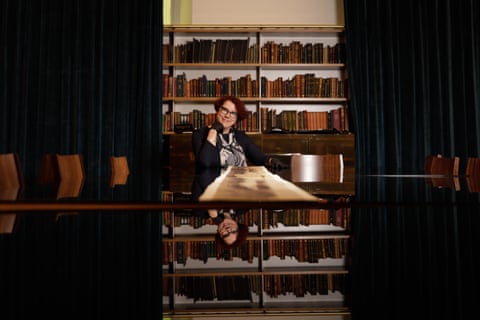The cultural historian Margot Riley from the State Library of New South Wales specialises in the history of photography and fashion, and has been a curator for more than 20 years. She takes Guardian Australia through some the library’s oldest images.
The earliest surviving portrait
How was it made? A daguerreotype was made using a copper plate, coated with a thin layer of silver which, after cleaning and polishing, was bathed in iodine vapour to create a light-sensitive surface. It was then placed inside the camera and exposed to produce a latent image which was then developed with mercury vapour. This process produced a positive image with a delicate mirror-like surface, which was sealed and stored in a protective case.

Backstory: This portrait is the earliest known surviving photograph taken in Australia. It was made by an entrepreneurial settler, George Baron Goodman, who was the first commercial photographer to work in Australia. Goodman had trained in Paris with the artist and chemist Louis Daguerre, who had invented the daguerreotype, which became the earliest viable form of commercial photography, in 1839. Goodman bought a licence to take photographs in the British colonies and, after arriving in Sydney in November 1842, set up his blue glass daguerreotype studio and immediately began capturing “faithful miniature likenesses” of the city’s leading citizens. This portrait depicts the ex-convict surgeon Dr William Bland, transported for murder as a result of a duel in 1813. Bland was pardoned in 1814 and became the first doctor to establish a private practice in the colony. He also became a member of parliament.
How old is this image? Made between late 1844 and early 1845, it’s 175 years old.
How much did it cost? A ninth-plate portrait like this one cost 21 shillings. That was the equivalent to one week’s wage for a labourer at the time. At the time, the price was said to be extremely moderate but it would still have been out of the reach of many.
The ambrotype
How was it made? This is a hand-coloured collodiotype on glass, also known as an ambrotype, which although it has the appearance of a positive image is actually a thin glass negative converted into a positive image by the addition of a black backing to create an optical illusion.
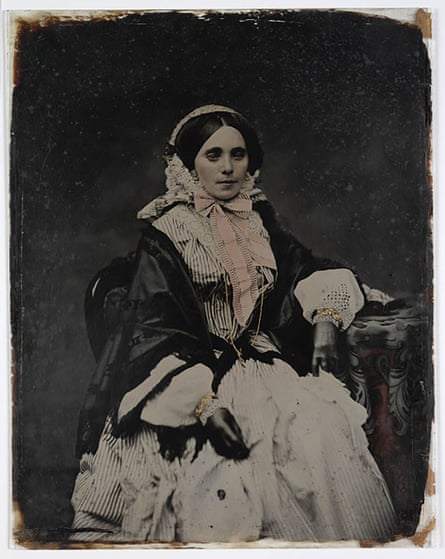
Backstory: This hand-coloured portrait of a fashionably attired woman is thought to have been made by the US-trained photographer Thomas Glaister, one of Australia’s most important early photographers, who set up his American Australian Portrait Gallery in Sydney in April 1855. A master of the ambrotype portrait, Glaister brought the technical sophistication, size and style of US photography to his local work – both in the daguerreotype and collodion processes.
How old is this image? It’s more than 160 years old – it was made in about 1857.
How much did it cost? Cheap and fast to make, ambrotypes ranged in price from half to a quarter the cost of a daguerreotype – approximately 10 shillings for standard small size.
The oldest surviving panorama of Sydney
How was this created? This panorama is made up of a series of 12 albumen photographs made by contact printing from wet-plate (ie, collodion) glass negatives.
Backstory: After 1858, the daguerreotype was eclipsed by the production of albumen paper prints from wet collodion glass negatives. While this was not the first panoramic photograph taken in Sydney, it is the oldest surviving example of an extended landscape view of the burgeoning city. The series of 11 photo prints making up this pioneering panoramic view was taken from the tower of Government House. Without access to a wide-angled lens, the Swedish born painter-turned photographer Olaf William Blackwood moved his camera through a carefully measured horizontal arc, completing a full 360-degree rotation on the spot to capture the view before him. Taking these 11 sequential and consecutive exposures, the photographer needed to work quickly to ensure the wet-plate emulsion didn’t dry out between shots. Within a week the three-metre-long photographic view was available for sale. Ambitious photographic products like Blackwood’s panorama were eminently suited to the growing market for local views, and shots documenting the progress of the colony were also intended for circulation to friends and family back home in Europe.
How old is the image? It was created in mid-1858.
How much did it cost? An advertisement on 9 Jun 1858 lists the price as: “Twelve beautiful Views of Sydney and its environs, photographed by Mr. W. Blackwood at 5 guineas [105 shillings].”
The stereograph
How was the image created? This stereograph streetscape was taken with a stereo-view camera producing an almost identical pair of wet-plate negatives contact printed to create two albumen prints placed side-by-side on a card mount which could be viewed simultaneously through an optical device known as a stereograph – held up to the eyes like a pair of binoculars – to create the illusion of three-dimensionality.

Backstory: In 1858 the Sydney photographer William Hetzer advertised “a novelty in the pictorial art … a judicious selection of 36 stereoscopic views of Sydney – its Harbour, principal buildings, streets and neighbouring scenery”. Funded by subscription, Hetzer’s stereoscope views were among the earliest outdoor photographs taken in Sydney, and were more extensive in their coverage than any others produced before this time.
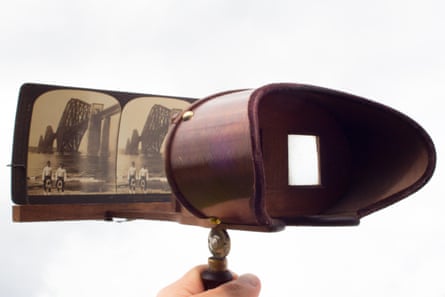
Hetzer, a German immigrant, had arrived in Sydney, with his wife, Thekla, in 1850. The couple set up a photographic studio at 15 Hunter Street. The Hetzers offered a range of photographic products including the new collodion-based positive/negative processes, such as ambrotype and albumen prints, as well as calotypes. The stereoscopic camera (available from 1855) had revolutionised the speed with which outdoor photographs could be taken. Viewing stereographs was popular from the mid-1850s through to the 1930s, both as a pastime for educational and entertainment purposes and as souvenirs of travel. Their uniform size meant people could collect the sets of views reproduced for sale by publishing houses.
How old is the image? This stereograph was part of Hetzer’s second series of stereo views produced in about 1859.
How much did it cost? Hetzer’s first series of stereo views were advertised on 25 September 1858: a full set of 12 slides cost 35 shillings.
The studio portrait
How were these images created? These small albumen photographs were direct contact printed from wet-plate glass negatives, then cut to size and pasted on to card.
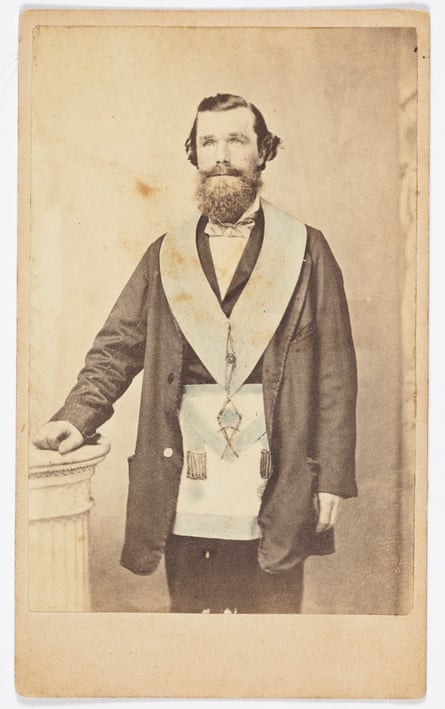
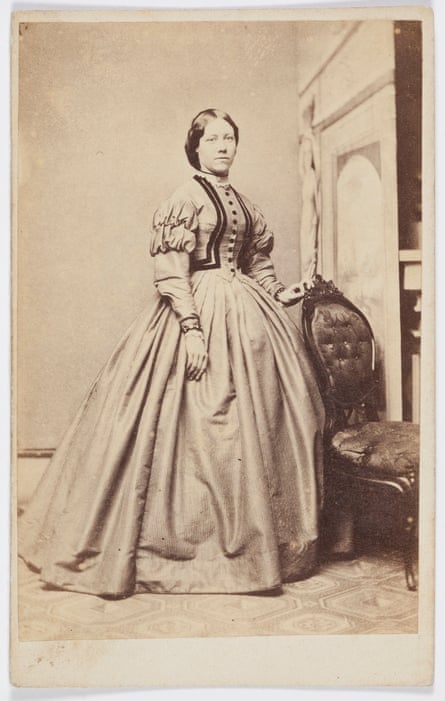
Backstory: By the 1860s the public were tired of expensive cased images (daguerreotypes and ambrotypes) and wanted something different and cheaper. The collodion wet-plate process produced a glass negative which enabled the production of multiple copy prints. Multi-lens, or “multiplying” cameras were introduced in this decade, capable of producing between two to 32 images in quick succession and dramatically increasing the number of photographic prints that could be made from a single photographic plate and offered in the style of a photographic visiting card, or carte de visite. Introduced to Sydney by William Blackwood in May 1859, the success of these cheap and reproducible paper photographs coincided with the influx of new settlers and professional studio photographers after the discovery of gold in New South Wales and Victoria in the early 1850s and was sustained by a new affluence, the desire to post likenesses “home”, and overseas interest in what was happening in Australia. As friends and relatives began to exchange visiting cards, the first family albums appeared. Developed in the late 1850s, these soon became common household items with most families having at least one. As the cartomania craze took hold the public’s thirst for celebrity images saw royalty and stars of the stage stored alongside family portraits.

Henry William Burgin was possibly NSW’s first native-born professional photographer and began taking photographs in the 1860s, at his watch-making premises in Church Street, Parramatta. Surviving images reveals the simple props, posing techniques and advertising stamps employed by Burgin’s studio, which lay at the crossroads between the coast and people moving to the west.

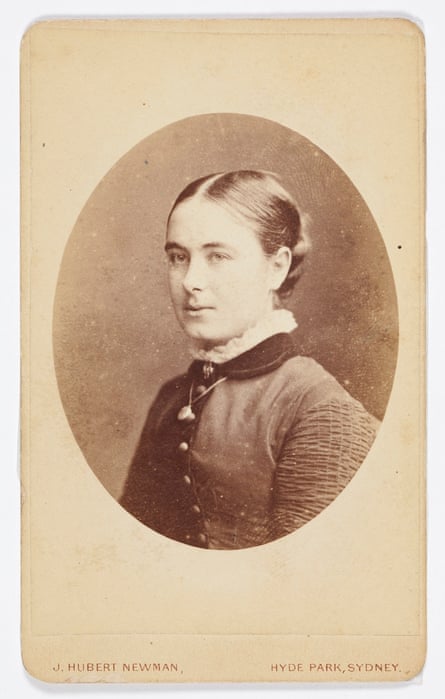
How old are these? This set of visiting cards was made in the 1860s.
How much did they cost? William Blackwood advertised the first “portraits on visiting cards” on 4 May 1959 at 12 shillings for 12 cards, but prices varied widely over time.
The large daguerreotype
How was the image created? By the mid-1850s, exposure time for daguerreotypes had been reduced to about 30 seconds but sudden movements from active children could still result in blurring. This image appears to have suffered from the effects of humidity and other environmental fluctuations, causing oxidising and tarnishing over time which suggests that case was not well sealed at the time it was made.

Backstory: This whole-plate daguerreotype shows George Walker Johnson, his wife Ann and three of their 13 children: from left to right, George William, Elizabeth and John Simpson. The Johnsons had travelled with the two eldest children overland to Kyneton, Victoria, a major supply town for the gold diggings, where they settled.
This photograph is rare because of its size and that the fact it can be dated quite precisely. The photograph appears to have been taken in summer – the short sleeves of both boys’ dresses show distinct tan lines on their upper arms and all the children wear socks rather than stockings. It can be dated quite precisely, based on the ages of the children, between late 1854 and the death of little George Jr on 30 January 1855. From its inception photography has held a great fascination because of its ability to accurately render the face. In the 19th century, a time of an age of high mortality regardless of social level, photographs of children had a special appeal beyond the natural desires of parents to fix the image of their offspring for posterity. With the passage of time, the significance of this family portrait shifted: initially providing material evidence of prosperity, it became a lasting image and memento memori.
How old is the image? It was taken in about 1855.
How much did it cost? The cost of a quarter-plate daguerreotype including a case had halved by late 1850s to about 11 shillings.
The calotype
How was the image created? This an extremely rare example of a colonial calotype (a salted print from a paper negative) created by an amateur/gentleman photographer. Few Australian calotypes are known but can recognised by the matte surface of the paper, as opposed to the glossy surface of an albumen photoprint. Introduced to Sydney by William Hetzer in 1850, the calotype seems to have disappeared by 1860.
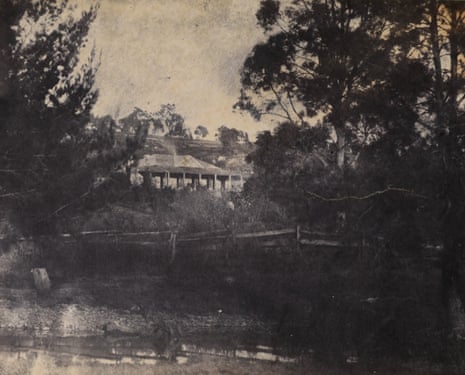
Backstory: One of Australia’s earliest amateur photographers, the surgeon and politician Joseph Docker lived chiefly on his estate, Thornthwaite, near Scone in the Hunter Valley district. He was an early enthusiast for photography and was described as one the most accomplished gentleman in the colony. In later life his son Ernest recorded that they had begun experimenting with the calotype process in about 1850, when Ernest was eight.
How old is it? This image was taken in about 1850.
How much did it cost? Calotypes were advertised at 5 shillings.
